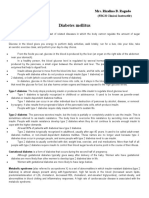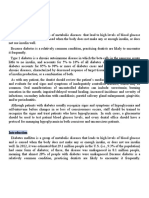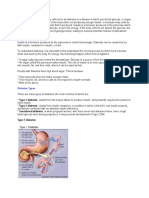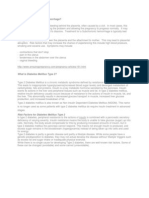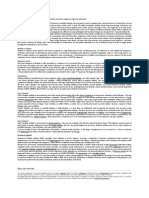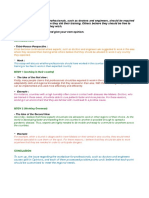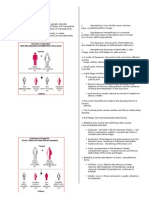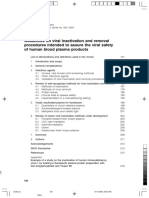Diabetic Melitus: Signs and Symptoms
Diabetic Melitus: Signs and Symptoms
Uploaded by
Esa AyuCopyright:
Available Formats
Diabetic Melitus: Signs and Symptoms
Diabetic Melitus: Signs and Symptoms
Uploaded by
Esa AyuOriginal Description:
Original Title
Copyright
Available Formats
Share this document
Did you find this document useful?
Is this content inappropriate?
Copyright:
Available Formats
Diabetic Melitus: Signs and Symptoms
Diabetic Melitus: Signs and Symptoms
Uploaded by
Esa AyuCopyright:
Available Formats
DIABETIC MELITUS
Diabetes is a condition that impairs the body's ability to process blood glucose, otherwise
known as blood sugar.In the United States, the estimated number of people over 18 years of age
with diagnosed and undiagnosed diabetes is 30.2 million. The figure represents between 27.9 and
32.7 percent of the population.Without ongoing, careful management, diabetes can lead to a
buildup of sugars in the blood, which can increase the risk of dangerous complications, including
stroke and heart disease.Different kinds of diabetes can occur, and managing the condition
depends on the type. Not all forms of diabetes stem from a person being overweight or leading
an inactive lifestyle. In fact, some are present from childhood.
Diabetes is due to either the pancreas not producing enough insulin, or the cells of the body not
responding properly to the insulin produced. There are three main types of diabetes mellitus:
1. Type 1 diabetes results from the pancreas's failure to produce enough insulin due to loss
of beta cells. This form was previously referred to as "insulin-dependent diabetes
mellitus" (IDDM) or "juvenile diabetes". The cause is unknown.
2. Type 2 diabetes begins with insulin resistance, a condition in which cells fail to respond
to insulin properly. As the disease progresses, a lack of insulin may also develop. This
form was previously referred to as "non insulin-dependent diabetes mellitus" (NIDDM)
or "adult-onset diabetes".The most common cause is a combination of excessive body
weight and insufficient exercise.
3. Gestational diabetes is the third main form, and occurs when pregnant women without a
previous history of diabetes develop high blood sugar levels.
Signs and symptoms:
The classic symptoms of untreated diabetes are :
1. unintended weight loss,
2. polyuria (increased urination),
3. polydipsia (increased thirst),
4. polyphagia (increased hunger)
Symptoms may develop rapidly (weeks or months) in type 1 diabetes, while they usually
develop much more slowly and may be subtle or absent in type 2 diabetes. Other symptoms of
diabetes mellitus include weight loss and tiredness.
Several other signs and symptoms can mark the onset of diabetes although they are not
specific to the disease. In addition to the known ones above, they include blurred vision,
headache, fatigue, slow healing of cuts, and itchy skin. Prolonged high blood glucose can cause
glucose absorption in the lens of the eye, which leads to changes in its shape, resulting in vision
changes. Long-term vision loss can also be caused by diabetic retinopathy. A number of skin
rashes that can occur in diabetes are collectively known as diabetic dermadromes.
WHO diabetes diagnostic criteria
Condition 2-hour Fasting glucose HbA1c
glucose
Unit mmol/l(mg/dl) mmol/l(mg/dl) mmol/mol DCCT %
Normal <7.8 (<140) <6.1 (<110) <42 <6.0
Impaired fasting glycaemia <7.8 (<140) ≥6.1(≥110) & 42-46 6.0–6.4
<7.0(<126)
Impaired glucose tolerance ≥7.8 (≥140) <7.0 (<126) 42-46 6.0–6.4
Diabetes mellitus ≥11.1 (≥200) ≥7.0 (≥126) ≥48 ≥6.5
Diabetes mellitus is characterized by recurrent or persistent high blood sugar, and is diagnosed
by demonstrating any one of the following:
Medications
There are a number of different classes of anti-diabetic medications. Some are available
by mouth, such as metformin, while others are only available by injection such as GLP-1
agonists. Type 1 diabetes can only be treated with insulin, typically with a combination of
regular and NPH insulin, or synthetic insulin analogs.
You might also like
- Biology Investigatory Project: Topic - DiabetesDocument19 pagesBiology Investigatory Project: Topic - Diabetesaditya gollakota83% (40)
- Diabetes: Diabetes Mellitus (DM), Commonly Known As Diabetes, Is A Group of MetabolicDocument4 pagesDiabetes: Diabetes Mellitus (DM), Commonly Known As Diabetes, Is A Group of MetabolicAnaDragomir100% (1)
- Diabetes Mellitus: Signs and SymptomsDocument2 pagesDiabetes Mellitus: Signs and SymptomsJosbel Alejandro RodríguezNo ratings yet
- Bio Project On DiabetesDocument17 pagesBio Project On DiabetesNishant KumarNo ratings yet
- DIABETES MELLITUS FinalDocument83 pagesDIABETES MELLITUS FinalYuvi Yuvaraj100% (1)
- Adobe Scan 4 Nov 2023Document10 pagesAdobe Scan 4 Nov 2023riddhimithastalinNo ratings yet
- Diabetes Mellitus ProjectDocument14 pagesDiabetes Mellitus ProjectathiyanathiyanaathiNo ratings yet
- Biology Investigatory ProjectDocument15 pagesBiology Investigatory ProjectRita NayakNo ratings yet
- Biology Project 12 CompleteDocument28 pagesBiology Project 12 Completearitrikapandey26No ratings yet
- Diabetes MellitusDocument24 pagesDiabetes MellitusAnsh Gaurav KumarNo ratings yet
- Diabetes MellitusDocument11 pagesDiabetes MellitusSallieNo ratings yet
- Deteksi Dini Kegawatdaruratan Maternal Dan Neonatal (RS Persada Medika Cikampek) PEBDocument10 pagesDeteksi Dini Kegawatdaruratan Maternal Dan Neonatal (RS Persada Medika Cikampek) PEBindra pradjaNo ratings yet
- Diabetes Mellitus: Osama Abosen ID:201341031Document6 pagesDiabetes Mellitus: Osama Abosen ID:201341031Raneem Al AliNo ratings yet
- DiabetesDocument34 pagesDiabetesqurat-ul-ain.sonNo ratings yet
- Biology Investigatory ProjectDocument8 pagesBiology Investigatory Projectbasheer9772No ratings yet
- Diabetes Mellitus Presentasi Bahasa Inggris 2Document13 pagesDiabetes Mellitus Presentasi Bahasa Inggris 2Denata Prabhasiwi0% (1)
- IntroductionDocument13 pagesIntroductionSaadNo ratings yet
- Diabetes MelitusDocument3 pagesDiabetes Melitusyashraj09122005No ratings yet
- Sweet Noon To AllDocument55 pagesSweet Noon To AllJheann Del Rio100% (1)
- Diabetes OverviewDocument38 pagesDiabetes OverviewKye GarciaNo ratings yet
- What Is Diabetes?: Get in Touch With A GP TodayDocument2 pagesWhat Is Diabetes?: Get in Touch With A GP TodayShekarNo ratings yet
- DiabetesDocument4 pagesDiabetesEZEQUIEL LUNA TIBURCIONo ratings yet
- DIABETES CorrectedDocument16 pagesDIABETES CorrectedBlaise PascalNo ratings yet
- Diabetes MellitusDocument44 pagesDiabetes Mellitusawadwafaa406No ratings yet
- DiabetesDocument4 pagesDiabetesTuTitNo ratings yet
- "Imagination Is More Important Than Knowledge."-EinsteinDocument38 pages"Imagination Is More Important Than Knowledge."-EinsteinYun NikNo ratings yet
- Diabetes MellitusDocument8 pagesDiabetes MellitusJaja RamosNo ratings yet
- Diabetes MellitusDocument8 pagesDiabetes MellitusJaja RamosNo ratings yet
- Diabetes MellitusDocument8 pagesDiabetes MellitusJaja RamosNo ratings yet
- Understanding Diabetes & Self Care Guideline - WDF03-060-1Document81 pagesUnderstanding Diabetes & Self Care Guideline - WDF03-060-1Muhammad Zukri MalikNo ratings yet
- Diabetes MellitusDocument21 pagesDiabetes MellitusJuri GallosNo ratings yet
- Diabetes: Oral Health TopicsDocument9 pagesDiabetes: Oral Health TopicsAndrei StamateNo ratings yet
- Diabetes Mellitu1, ShkurtDocument7 pagesDiabetes Mellitu1, ShkurtAjet AsaniNo ratings yet
- Type 1 DiabetesDocument11 pagesType 1 DiabetesLyne Paggic PabloNo ratings yet
- Physiology and Causes of DiabatesDocument7 pagesPhysiology and Causes of DiabatesasaadsarfrazNo ratings yet
- Nutrition.. 12Document31 pagesNutrition.. 12Samee PatilNo ratings yet
- Diabetes MellitusDocument11 pagesDiabetes MellitusChristinaRegatilloNo ratings yet
- Case Study in DMDocument34 pagesCase Study in DMKathrina Marie B. BinaraoNo ratings yet
- Disease EssayDocument8 pagesDisease EssayMohammed AbouelimamNo ratings yet
- 3 Case Study On DM p.35 1Document44 pages3 Case Study On DM p.35 1Nina Fatima AllamNo ratings yet
- Diabetes MellitusDocument12 pagesDiabetes MellitusAli Khan pashtoonNo ratings yet
- Understanding DiabetesDocument13 pagesUnderstanding DiabetesBratati100% (1)
- Catholic University of Santiago de Guayaquil Faculty of Arts and HumanitiesDocument6 pagesCatholic University of Santiago de Guayaquil Faculty of Arts and HumanitiesMari VargasNo ratings yet
- Diabetes MellitusDocument6 pagesDiabetes MellitusChristian YuNo ratings yet
- Is Project: Diabetes MellitusDocument6 pagesIs Project: Diabetes MellitusLawHok KanNo ratings yet
- What Is A Subchorionic HemorrhageDocument4 pagesWhat Is A Subchorionic HemorrhageBudo LataquinNo ratings yet
- Diabetes Mellitus DMC 6th SemesterDocument23 pagesDiabetes Mellitus DMC 6th SemesterHuzaifa CHNo ratings yet
- Diabetes: Causes, Incidence, and Risk FactorsDocument8 pagesDiabetes: Causes, Incidence, and Risk FactorsJasmine RoweNo ratings yet
- Diabetes - Mellitus - 1 - Y2 - 280915Document24 pagesDiabetes - Mellitus - 1 - Y2 - 280915azizan hannyNo ratings yet
- Facultatea de Medicina Si Farmacie ORADEA 2018/2019: Dr. Mdalina PanteaDocument22 pagesFacultatea de Medicina Si Farmacie ORADEA 2018/2019: Dr. Mdalina PanteaTawfiq GhantousNo ratings yet
- Bka Case FinalDocument26 pagesBka Case FinalJayson SorianoNo ratings yet
- Definition and Diagnostic Criteria For Diabetes Mellitus and Other Categories of Glucose IntoleranceDocument4 pagesDefinition and Diagnostic Criteria For Diabetes Mellitus and Other Categories of Glucose Intolerancevai2No ratings yet
- DiabetesDocument14 pagesDiabetesBocah JomloNo ratings yet
- Diabetes Mellitus Urata Abazi 11.8Document32 pagesDiabetes Mellitus Urata Abazi 11.8Urata AbaziNo ratings yet
- DiabetesDocument99 pagesDiabetes489226fahimNo ratings yet
- Diabetes LC Medical 2Document7 pagesDiabetes LC Medical 2Putu Alen RenaldoNo ratings yet
- DM 2022Document49 pagesDM 2022nicksonphilipo1No ratings yet
- Clinical Presentation, Diagnosis, and Initial Evaluation of Diabetes Mellitus in Adults - UpToDateDocument22 pagesClinical Presentation, Diagnosis, and Initial Evaluation of Diabetes Mellitus in Adults - UpToDatepeishanwang90No ratings yet
- How to Manage Diabetes and Cure?: Dr. Alan's Step By Step Guide for Diabetes Management Including General Tips, Diet Plan, Exercise Routine and Much More!From EverandHow to Manage Diabetes and Cure?: Dr. Alan's Step By Step Guide for Diabetes Management Including General Tips, Diet Plan, Exercise Routine and Much More!No ratings yet
- Bone Fracture HealingDocument13 pagesBone Fracture HealingMustafa HasanNo ratings yet
- Abdominal Pain - Royal Children HospitalDocument4 pagesAbdominal Pain - Royal Children HospitalMehrdad IraniNo ratings yet
- Barra Briceida ResumeDocument1 pageBarra Briceida Resumeapi-661287616No ratings yet
- PP of RGHDDocument96 pagesPP of RGHDNadeem PervaizNo ratings yet
- Types of Studies - NRC Research Institute (FDA)Document3 pagesTypes of Studies - NRC Research Institute (FDA)Muhammad ReyhanNo ratings yet
- NLEDocument18 pagesNLEKeij AranetaNo ratings yet
- Introduction To Pharmacovigilance UNIT - 1Document58 pagesIntroduction To Pharmacovigilance UNIT - 1meghana vasNo ratings yet
- Speaking Outline For Informative SpeechDocument11 pagesSpeaking Outline For Informative SpeechacrushfitnessNo ratings yet
- Writing Project - Soap Note MemorandumDocument2 pagesWriting Project - Soap Note Memorandumapi-340006591No ratings yet
- LSPN Registration FormDocument13 pagesLSPN Registration Formbobby adleNo ratings yet
- Drtbalu'S Otolaryngology Online: Acute LaryngitisDocument3 pagesDrtbalu'S Otolaryngology Online: Acute LaryngitisAnish RajNo ratings yet
- Jurnal Retinopaty DiabetikumDocument11 pagesJurnal Retinopaty DiabetikumrestikaNo ratings yet
- Robotic Surgery: Niraj BhalakiaDocument20 pagesRobotic Surgery: Niraj Bhalakiardm entertainmentNo ratings yet
- Infection Control NHS PolicyDocument12 pagesInfection Control NHS PolicyYahya Salem100% (1)
- IELTS Discuss Both Views QuestionDocument2 pagesIELTS Discuss Both Views QuestionOngky SetiawanNo ratings yet
- (Hepatology Research and Clinical Developments) Miranda L. Michelli-Liver Cirrhosis - Causes - Diagnosis and Treatment (Hepatology Research and Clinical Developments) - Nova Science Pub Inc (2011) PDFDocument303 pages(Hepatology Research and Clinical Developments) Miranda L. Michelli-Liver Cirrhosis - Causes - Diagnosis and Treatment (Hepatology Research and Clinical Developments) - Nova Science Pub Inc (2011) PDFnoname19191100% (2)
- Assessment Diagnosis Planning Intervention Rationale Evaluation Short Term GoalDocument3 pagesAssessment Diagnosis Planning Intervention Rationale Evaluation Short Term GoalJanelle Cabida SupnadNo ratings yet
- Hemophilic ArthropathyDocument2 pagesHemophilic ArthropathyKimmybee GarciaNo ratings yet
- Cmi CMBDocument7 pagesCmi CMBMary M. ToribioNo ratings yet
- Who TRS 924 A4Document75 pagesWho TRS 924 A4Andres AbrilNo ratings yet
- Presentation Diagnosis of Diabetes Mellitus: Presented by Kanwal AmjadDocument29 pagesPresentation Diagnosis of Diabetes Mellitus: Presented by Kanwal AmjadSpencerNo ratings yet
- Anesthetics and Anesthesiology: ClinmedDocument6 pagesAnesthetics and Anesthesiology: ClinmednadaNo ratings yet
- S1130862120305131Document5 pagesS1130862120305131marisaNo ratings yet
- Merck Annual Report 2016Document231 pagesMerck Annual Report 2016Ojo-publico.comNo ratings yet
- Medscimonit 25 5717Document10 pagesMedscimonit 25 5717Nurfitriah NasirNo ratings yet
- Persuasive Essay On Eating DIsordersDocument3 pagesPersuasive Essay On Eating DIsordersNicole SantiagoNo ratings yet
- Mcqs in Physiology Medical About The Authors Mcqs in Medical PhysiologyDocument2 pagesMcqs in Physiology Medical About The Authors Mcqs in Medical PhysiologyIsrael TarekegnNo ratings yet
- Emotional DistressDocument12 pagesEmotional DistressfantasighNo ratings yet
- 1 s2.0 S1028455920301753 MainDocument4 pages1 s2.0 S1028455920301753 MainAditi SoniNo ratings yet
- Asthma BrochureDocument2 pagesAsthma Brochureapi-388768606No ratings yet


























